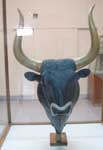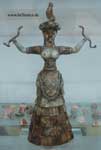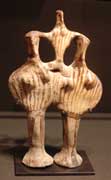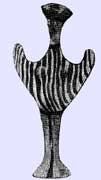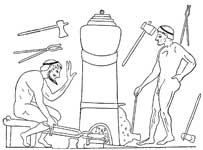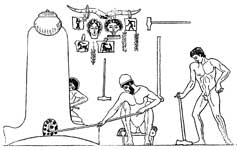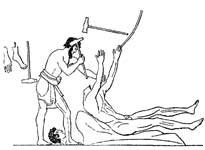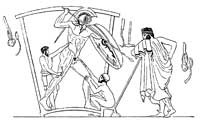.
Parts : 1 - 2 - 3 - 4 - 5 - 6 - 7 - 8 -

Art is science made clear.
Jean Cocteau (1889-1963)
Not what man knows but what man feels, concerns art. All else is science, Bernand Berenson, 1897 American art critic and writer
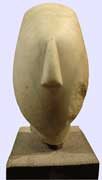
Minoan Sculpture
|
Mycenean figurines
|
|
|
Psi - figurines |
|
... the pre-Hellenes ... were conquered by cattle-herding Indo-Europeans, marauders who swept down from the Caucasus in waves, the first around 2200 BC, the second just two hundred years later ...Being patriarchal, the conquerors banished womanly charms from the local artwork and imposed a fixation on more masculine things: a man fighting a centaur, men hunting a lion with the help of dogs, and, the real key, statuettes of horses, those sources of speed and power which lifted heroes from the ground on which mere women walked. Howard Bloom Greece, Miletus and Thales - The Birth of the Boundary Breakers - 3000 BC to 550 BC.
Geometric Period (900-700 BC)
Archaic Period (600-480 BC)
In the Archaic Period influence of Egypt and Mesopotamia but the Greek character dominating . At the end of this period a fast revolution towards realism. Male and Female sculptures, the Kouros and Kore respectively. A little smile on the face is probably used as a sign of vitality (archaic smile). The statue body straight up with sometimes one foot forward and the fists clenched at the sides..
Early (transitional and severe) and High Classical Style (480-400 BC or just 5th century BC)
In the classic Period actually Art was more a “product”. The interest was in producing perfect “idealistic” sculptures.
Late Classical Period (4th century BC, 430-323 BC)
Hellenistic Period (323-30 BC)
In the Hellenistic Time we have a transition to more realism, more freedom in inventions, a shift to true Art.
Greek Art was discovered during Renaissance and became the standard in Art until the 19th Century
Ancient Greek Sculptures
Christianity defeated and wiped out the old faith of the pagans. Then with great fervour and diligence it strove to cast out and utterly destroy every last possible occasion of sin; and in doing so it ruined or demolished all the marvelous statues, besides the other sculptures, the pictures, mosaics and ornaments representing the false pagan gods; and as well as this it destroyed countless memorials and inscriptions left in honor of illustrious persons who had been commemorated by the genius of the ancient world in statues and other public monuments…their tremendous zeal was responsible for inflicting severe damage on the practice of the arts, which then fell into total confusion. Giorgio Vasari (1511-1574), Lives of the Artists.
As Winckelmann writes in the period of Constantine many pagan sculptures were destroyed in Greece. Temples were transformed by using their material into Palaces and other buildings. In 60 years after Byzanz was declared as the capital of the East Roman Empire Athens practical lost all its pieces of Art. Some masterpieces transported to Constantinople Byzanz such as the Zeus of Olympia and Aphrodite of Cnidus which survived the attacks were destroyed later by fires and other reasons. In the western Roman Empire a Centurio nitentium rerum and his soldiers were responsible to protect pagan Art from destruction.
Statue or Agalma in Greek means “thing to delight the gods”. The sculptor is called agalmatopoios or andriantopoios, a maker of gods or men respectively. According to a story the athlete Theagenes of Thasos was memorized by his statue which a man who never could win against Theagenes in the Olympic Games was beating every night. One night the statue fell on this man after the basis became loose and killed the man. His sons then prosecuted the statue for murder! The result was that the statue of Theagenes was dropped into the sea. Later the people of Thasos recovered the statue after a plague struck the island and after an advice of an Oracle.
Greeks artists were probably the first who signed their work. Sculptures were very important for the Greeks. Pausanias in his description of Greece discusses a large number of sculptures that he found in various cities. A large number of marble sculptures have been destroyed by using these as building material after the early Byzantine Christian Emperors ordered the destruction of all pagan related sculptures. Some good examples survived as private pieces belonging to the upper class, such as the Aphrodite of Cnidus that was transported to Constantinople.
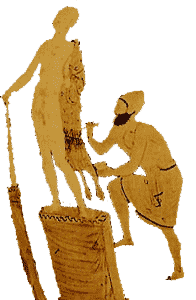
Encaustic method. A sculpture painter. 4th century BC
Metal processing, Sculptors, Click Images to Enlarge
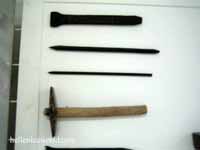
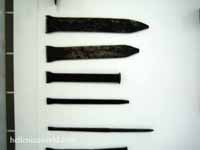
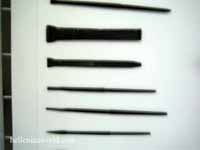

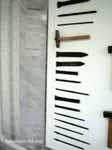
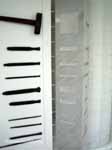
Stone processing tools, Dion Archaeological Museum
An old publication about Antique Marble, including Parian Marble (requires free available DJVU Viewer)
Greek sculptures were different from what we usually see today from the copies or originals that survived. Greek sculptures were painted and these two arts sculpture and painting were combined together to increase the reality. I provide some colored versions in order to give an idea. Of course I do not know the exact colors used. The Glyptothek in Munich provided recently new amazing colored versions of some Aphaia temple statues by analyzing traces of color.
Modern man, contemplating a piece of art in a living room, a museum or a gallery, may derive pleasure or even an emotional experience if the subject moves him. But he remains essentially detached and alien to the work of art. The intentions of the artist remain obscure or may be misunderstood. Besides, modern artists are notorious for refusing to tell the public what they intend. (The Role of Wall-Paintings in the Bronze Age) What was the role of the blue Santorini monkeys fresco beyond decoration? Interesting are pieces of ancient Greek Art that are associated with stories even if we do not know exactly the details. Why did Laokoon not look at his sons but towards the sky? Is it because he was blind or just because he had enough to do trying to save his life?
Next : Sculptures from the Archaic to the Hellenistic Period
| Ancient Greece
Science, Technology , Medicine , Warfare, , Biographies , Life , Cities/Places/Maps , Arts , Literature , Philosophy ,Olympics, Mythology , History , Images Medieval Greece / Byzantine Empire Science, Technology, Arts, , Warfare , Literature, Biographies, Icons, History Modern Greece Cities, Islands, Regions, Fauna/Flora ,Biographies , History , Warfare, Science/Technology, Literature, Music , Arts , Film/Actors , Sport , Fashion --- |

